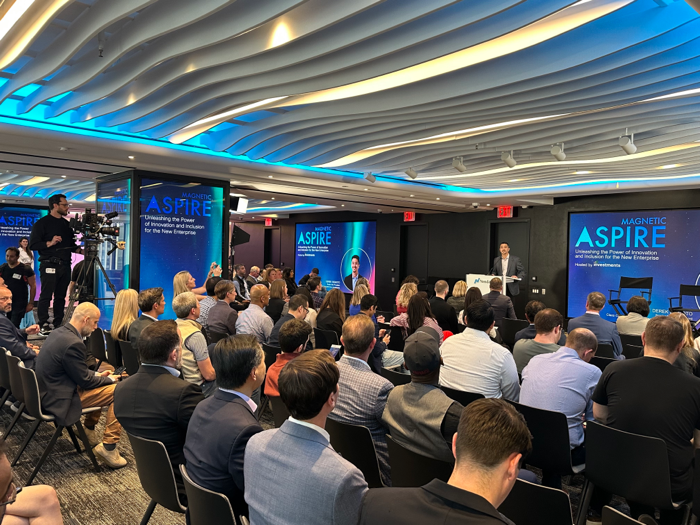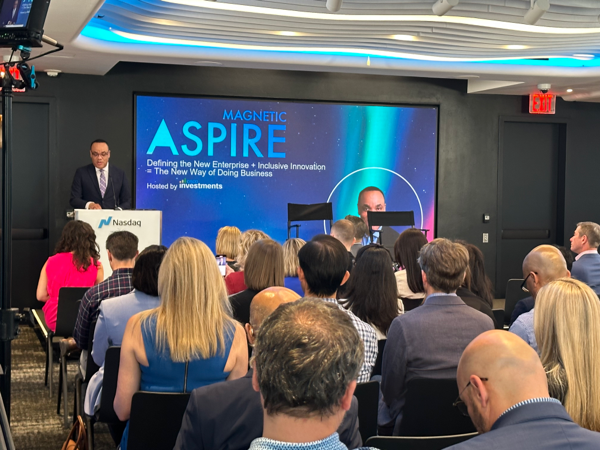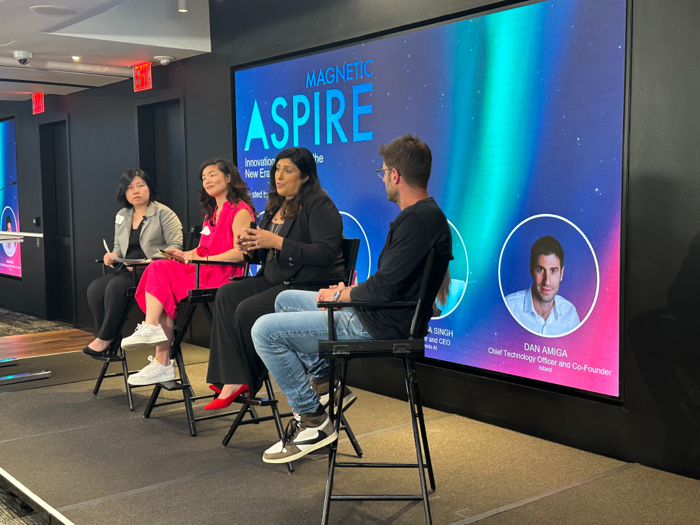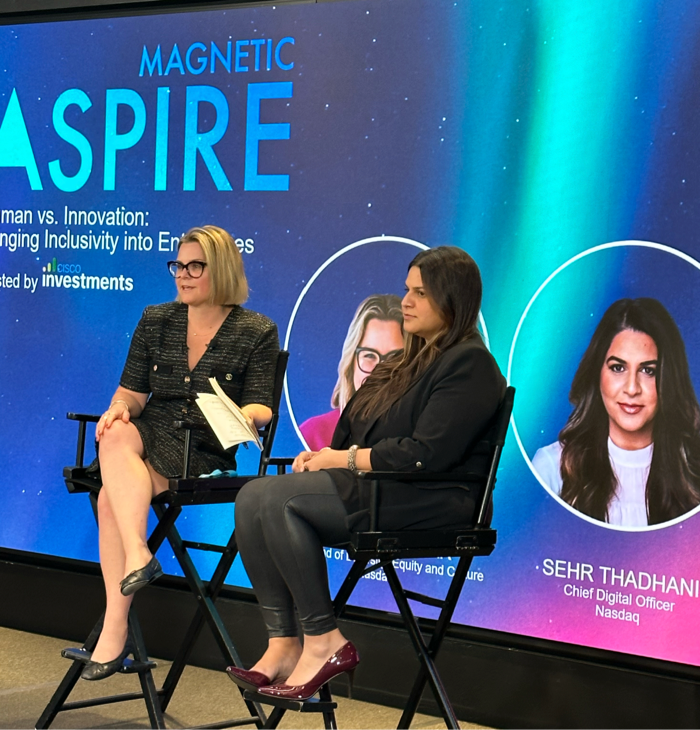On a Tuesday afternoon this past May, more than 130 startup founders, tech leaders, customers, and investors came together for Magnetic Aspire, at NASDAQ HQ in Times Square, New York City. Their goal: understanding the evolving challenges of a new, borderless enterprise, and, how innovation and inclusion could help shape this new landscape.
“This new enterprise represents a shift in mindset, in which enterprises and technology companies alike commit to understanding and investing in diverse talent and strategic innovations that will help them navigate and thrive in any macro environment,” said Derek Idemoto, SVP of Corporate Development and Cisco Investments, in opening the event.
Hosted by Cisco Investments and NASDAQ, Magnetic Aspire came just over two-and-a-half years since Cisco and Cisco Investments launched the Aspire Fund — an initial $50 million fund focused on financing and scaling diverse-led startups and VC funds. The vision behind the fund is to provide equal access to capital and opportunities, and to accelerate growth with Cisco’s support in order to create a positive change in the venture ecosystem. It also supports Cisco’s purpose to power an inclusive future for all.

Opening Remarks
Featuring Derek Idemoto, SVP, Cisco Investments

Defining the New Enterprise + Inclusive Innovation = The New Way of Doing Business
Featuring Brian Tippens, SVP and Chief Social Impact Officer, Cisco

Innovations Powering the New Era of Enterprise
Panel session (l to r) with Janey Hoe, VP, Cisco Investments, Jessic Lin, Co-founder & General Partner, Work-Bench, Navrina Singh, Founder and CEO, Credo AI and Dan Amiga, CTO and Co-founder, Island

Human vs. Innovation: Bringing Inclusivity into Enterprises
Fireside chat (l to r) with Laura Agharkar, Global Head of Diversity, Equity, and Culture, Nasdaq and Sehr Thadhani, Chief Digital Officer, Nasdaq
DEI Driving Employee Engagement
At a time when DEI initiatives are being politicized, Cisco and NASDAQ came together to advocate to attendees that inclusion — like innovation — is a business imperative for every enterprise. Nasdaq introduced an Inclusion index in its recent People Pulse Survey to gauge employee sentiment. Data from the survey (which had 93% employee participation) showed that Inclusion is one of the main drivers of employee engagement at Nasdaq.
A key to helping enterprises continue to grow and thrive in these challenging times is changing systems. Enterprises need to transform their advocacy for DEI into a global, enterprise-wide commitment to bolder action and greater impact. A systems approach to change means increasing full-spectrum diversity across the board. That includes bringing change in hiring practices and board of directors' representation, expanding the community, actively generating and fostering diverse talent benches, and building a culture of sponsorship across dimensions of difference.
The takeaway: Fostering an inclusive culture is a business imperative, not a trend or nice-to-have. The new enterprise knows that the future is inclusive and actively seeks to invest in programs and systems to foster this in order to remain on the leading edge.
Here are two additional key points highlighted by speakers at the Aspire event:
1. The new enterprise is mission critical
Enterprises need to find ways to avoid downtime, boost reliability and resiliency, and guarantee services. Technology outages burn bridges between businesses and customers. Dan Amiga, CTO and Co-founder of Island, drew a line between resiliency and security to what he called a “consumer-grade experience.”
“For me, the new enterprise is all about user experience, it's about privacy,” he said. “It's really about bringing the consumer experience, where we buy a new laptop and it's wonderful. But, then we switch to the corporate network, which is 20 to 30 years old, and it doesn’t work quite as well. The new enterprise needs new tools, new innovation, to achieve what I call the consumer-grade experience.”
Jessica Lin, founder and general partner of Work-Bench, echoed those sentiments.
“It isn’t just about the product,” she explained, “it’s still so much the people and processes in the enterprise that you have to win over.”
2. Governance and Regulation of AI
The new enterprise is coming of age at a time when AI, new security paradigms, and other dynamic innovations are transforming the world and will exist in a new compliance and regulatory environment to ensure innovations are in the interests of humanity. For the new enterprise, responsibility and accountability must be front and center in how they build and deliver technologies.
The responsibility for a well-governed organization is up to everyone, from C-level executives to the developers building AI systems to everyone across the ecosystem. The new enterprise must find a way to bridge the gap — the misalignment of incentives — between business stakeholders and technical stakeholders.
As Navrina Singh, founder and CEO of Credo AI, put it: “In this new age of AI transformation, governance actually is going to be an accelerant for your businesses. Regulation is actually going to be a good thing, because it’s going to help you build that trust with those different stakeholders.” The new enterprise will embrace regulations and not hesitate to put governance structures in place.
The rise of the new enterprise emphasizes the significance of diversity, inclusion, and innovation as key business drivers. Fostering an inclusive culture is no longer a trend but a mission-critical imperative for enterprises to remain competitive and resilient. By embracing diversity, responsible governance, and regulatory changes, the new enterprise is poised to shape a successful and transformative future.
To learn more about Cisco Investments and the Aspire Fund, please visit www.ciscoinvestments.com/aspire-fund.

